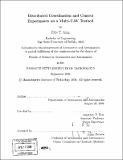Distributed coordination and control experiments on a multi-UAV testbed
Author(s)
King, Ellis T. (Ellis Taylor), 1979-
DownloadFull printable version (9.347Mb)
Other Contributors
Massachusetts Institute of Technology. Dept. of Aeronautics and Astronautics.
Advisor
Jonathan P. How.
Terms of use
Metadata
Show full item recordAbstract
(cont.) of environmental disturbances and measurement noise.The product of this thesis is a robust planning system that is tolerant of the types of uncertainty experienced by real aircraft. This robustness has been demonstrated by more than 20 successful flights on a fully automated UAV testbed. This thesis presents the development and testing of a unique testbed consisting of a fleet of eight unmanned aerial vehicles (UAVs) that was designed as a platform for evaluating coordination and control algorithms. A hierarchical configuration of task assignment, trajectory design, and low-level, waypoint following, are used in a receding horizon framework to control the UAV system. Future UAV teams will have to autonomously demonstrate cooperative behaviors in dynamic and uncertain environments, and this testbed can be used to compare various control approaches to accomplish these coordinated missions. Flight demonstrations are made utilizing real-time mixed-integer linear programming techniques, exercising the algorithms in realistic environments with real-world disturbances. Large disturbance sources, computational delay and measurementnoise all represent significant error sources that reduce the ability of UAV teams to interact in a coordinated fashion by increasing uncertainty on higher planning levels. This thesis develops a method that explicitly accounts for this uncertainty by including feedback loops on the task assignment and trajectory design algorithms to prescribe added robustness for the uncertainty at each stage. This approach takes into account low level controller saturation limits that might cause infeasibilities in the plans created at the higher levels of the planning system. Detailed and realistic simulation environments are useful for large-scale multi-vehicle simulations, particularly when logistics prevent flight testing on that scale. This thesis validates one such hardware-in-the-loop simulation environment through the comparison of models obtained from experimentally collected flight data and detailed modeling
Description
Thesis (S.M.)--Massachusetts Institute of Technology, Dept. of Aeronautics and Astronautics, 2004. Includes bibliographical references (p. 153-157).
Date issued
2004Department
Massachusetts Institute of Technology. Department of Aeronautics and AstronauticsPublisher
Massachusetts Institute of Technology
Keywords
Aeronautics and Astronautics.